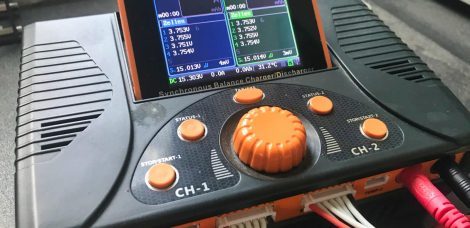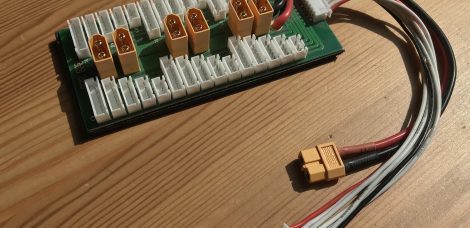German distributor and manufacturer Pichler Modellbau lately introduced it’s newest battery packs targeting at the mini quad market. The latest version now comes with XT60 connectos pre-equipped ready to be used with most mini quads out there. We ran the new LemonRC 4S 1600 mAh 70C on our test stand.
Appearance
The new LemonRC* packs come packed in a simple plastic bag. The package was very well cushioned, though. The outer appereance is nice, the pack seems very well made in terms of build quality. The pack is transparently shrink wrapped with a carbon-style layer on the inside that holds all the printed logos and information. Data and warning messages are printed in German as well as in English. Overall the battery features the same design as the 1800 mAh already tested.
Technical Design
The LemonRC* 70 C packs are based on Fullymax LiPo cells. The pack is a standard 4S1P config flight pack for high power use. A foam layer on the front and pack provides extra impact protection on the cell edges.
Build Quality: Very good. Pack feels very well made on the outside. Connection terminal looks solid.
Plugs: The LemonRC pack comes with XT60 connectors* pre-installed.
Cables: LemonRC / Pichler uses 14 AWG wires on this packs. The high flexible silicon layer is rated up to 200°C. Cable length is about 9.5 centimeters.
Balacing plugs: Standard XT-system*. Balance wires are rather short (3 cm) which is a benefit in terms of getting them out of the prop-range on the aircraft. Main power line and balancing wires are coming out of the same side of the pack (top).
Technical Details
| Manufacturer | Pichler* | 
(Click to enlarge.) |
| Type | LemonRC 70 C | |
| Cell chemistry | Lithium Polymere (LiPo) | |
| Cell type | Fullymax LiPo | |
| Cell count | 4 | |
| Pack configuration | 4S1P | |
| Capacity | 1600 mAh | |
| Max. Charge Current | 1,6 A | |
| Max. Discharge Current Continuous Burst |
45.5 A |
|
| Weight w/o plugs with plugs |
– |
|
| Measurements as listed measured |
90 x 37 x 33 mm |
|
| Price | 35,95 €* | |
| Note | This battery has been directly donated by the manufacturer / distributor for review purposes. |
Break-in documentation
The battery followed the standard break-in-process: The pack is charged at a rate of 1C until CV-phase ends with current of 1/10C. The break-in phase consists of four charging cycles at 1C and four corresponding discharges at 1 C / 4C / 10C and 20 C.
Anomalies: No anomalies during break-in.
Charging process
Sie sehen gerade einen Platzhalterinhalt von Google Tabellen. Um auf den eigentlichen Inhalt zuzugreifen, klicken Sie auf den Button unten. Bitte beachten Sie, dass dabei Daten an Drittanbieter weitergegeben werden.
CV-Phase is short on this cell type. Balancing in normal mode only took 1:10 mins. Cell drift during charge was unobtrusive. This is for 1C charge (1,6 A).
Load Testing
The main part of this battery test will consists of different load test settings showing the battery performance. Constant load testing is used to judge the advertised C-ratings as well as look at cell drift under high loads. We also check on internal resistance once more. Next up is the dynamic current test, which simulates a „real“ flight with changing (=dynamic) loads. For test methodology please check the dedicated methodology page!
Constant Load Testing
Constant load testing follows a certain load pattern of different constant currents. Base load is 10 C. Current pulses at 50 C, 35 C, 20 C and 30 C are maintained for time intervals between 10 and 20 seconds. For more details please refer to the test methodology page.
Sie sehen gerade einen Platzhalterinhalt von Google Tabellen. Um auf den eigentlichen Inhalt zuzugreifen, klicken Sie auf den Button unten. Bitte beachten Sie, dass dabei Daten an Drittanbieter weitergegeben werden.
Capacity Usage
During this test the pack delivered 1176 mAh. This is 73.5 % of nominal capacity. A very solid value.
Average cell voltages
The following table lists the average voltages per cell, of the total pack, as well as the averaged value per cell as fraction of total voltage during phase of active load.
| Cell 1 | Cell 2 | Cell 3 | Cell 4 | Total | Average per cell | |
| Avg. Voltages | 3.772 V | 3.77 V | 3.776 V | 3.777 V | 15.094 V | 3.774 V |
Just looking at average values the Tattu pack performs really good. All cells stayed well above 3,7 V on average (3.77 V / cell to be exact, which is pretty nice).
Focus Voltages
Exceptionally interesting when testing a battery under a constant load for a longer period of time: the lowest voltage per cell just before load impulse is disabled. On top, you should have look at voltage recovery rate, that is: how fast do cell voltages rise again once load impulse is cut.
| Phase | Cell 1 | Cell 2 | Cell 3 | Cell 4 | Total |
| End of 50 C | 3.641 V | 3.644 V | 3.661 V | 3.675 V | 14.62 V |
| End of 35 C | 3.57 V | 3.569 V | 3.589 V | 3.598 V | 14.327 V |
| End of 20 C | 3.254 V | 3.246 V | 3.28 V | 3.357 V | 13.137 V |
The LemonRC pack* showed solid performance during first two current pulses. Whether during 50 C or during 35 C pulse: No cell dropped below 3,5 V.
Average voltage recovery per second
Those values are specific to the test setting and not valid for the pack in general!
| Cell 1 | Cell 2 | Cell 3 | Cell 4 | Total | |
| Avg. Recovery | 0.0287 V / s | 0.0285 V / s | 0.0261 V / s | 0.0236 V / s | 0.1068 V /s |
IR-Measurement
IR measurement is conducted using the four current pulses. Resistance for each cell is calculated in all four discharge phases. Shown values are averaged to cancel out different temperature points due to different discharge states during measurements.
| Cell | 1 | 2 | 3 | 4 | Total |
| Resistance [mΩ] | 2.02 | 1.98 | 1.76 | 1.9 | 7.65 |
Interpretation: The internal resistance of 1.91 mΩ average per cell indicates a „true“ C-rating of around 44 C (70.9 A). This is on the conservative side and represents a current draw that will make the pack last for a long time. The pack had no problems delivering during high C discharge pulses. Voltage stayed well above 3.5 V on this test for 50 C and 35 C loads. The internal resistance is one of the lowest we have measured to date.
Cell drift under load
Cell drift of the LemonRC 1600 mAh pack is low as well. Our test sample was almost perfectly matched. This is rare on todays lipo market. Very good work.
| Discharge Phase | 50 C | 35 C | 20 C | 30 C |
| Max Cell drift (V) | 0.01 V | 0.029 V | 0.111 V | – |
Key Temperature Facts
Temperature Development
Sie sehen gerade einen Platzhalterinhalt von Google Tabellen. Um auf den eigentlichen Inhalt zuzugreifen, klicken Sie auf den Button unten. Bitte beachten Sie, dass dabei Daten an Drittanbieter weitergegeben werden.
All temperature probes reported values below cut-off point at 58°C. Max. temp during discharge was around 54.5 °C on top of the pack. Note that heating of stressed LiPo packs will continue for some more time even when load is cut.
Market Comparison
The following chart shows all reviewed LiPos in the same product segment for direct comparison of performance. Higher values under load are better.
Sie sehen gerade einen Platzhalterinhalt von Google Tabellen. Um auf den eigentlichen Inhalt zuzugreifen, klicken Sie auf den Button unten. Bitte beachten Sie, dass dabei Daten an Drittanbieter weitergegeben werden.
Constant 25 C Discharge
Pretty much a standard benchmark in the LiPo industry.
Sie sehen gerade einen Platzhalterinhalt von Google Tabellen. Um auf den eigentlichen Inhalt zuzugreifen, klicken Sie auf den Button unten. Bitte beachten Sie, dass dabei Daten an Drittanbieter weitergegeben werden.
Cut-Off /warning value for this battery should be chosen 3.5 V minimum. After this point voltage drops quick. The battery provided 1167 mAh (72.9 %) during the 25 C discharge.
Market Overview
Comparison of different reviewed 1600 mAh batteries under 25 C load.
Sie sehen gerade einen Platzhalterinhalt von Google Tabellen. Um auf den eigentlichen Inhalt zuzugreifen, klicken Sie auf den Button unten. Bitte beachten Sie, dass dabei Daten an Drittanbieter weitergegeben werden.
Dynamic Load Testing
The dynamic load testing setting consists of two separate discharge scenarios that have been developed of two different real-life FPV flights. Pattern one represents a high speed low proximity flight around the open field with some hovering to the end. Average load is around 22 A. Second pattern is a free-style flight around trees in the park with some current spikes near 70 A. Average load on this flight is around 13 A due to longer floating periods.
Sie sehen gerade einen Platzhalterinhalt von Google Tabellen. Um auf den eigentlichen Inhalt zuzugreifen, klicken Sie auf den Button unten. Bitte beachten Sie, dass dabei Daten an Drittanbieter weitergegeben werden.
Sie sehen gerade einen Platzhalterinhalt von Google Tabellen. Um auf den eigentlichen Inhalt zuzugreifen, klicken Sie auf den Button unten. Bitte beachten Sie, dass dabei Daten an Drittanbieter weitergegeben werden.
Capacity Usage
During the test of pattern 1 the pack delivered 1167 mAh. This is 82.9 % of nominal capacity. A solid result. In pattern 2 the LemonRC pack yielded 1163 mAh. That’s 72.7 % of nominal capacity.
Market Comparison
The following charts give an overview of all tested packs in the 1600 mAh class so far.
Sie sehen gerade einen Platzhalterinhalt von Google Tabellen. Um auf den eigentlichen Inhalt zuzugreifen, klicken Sie auf den Button unten. Bitte beachten Sie, dass dabei Daten an Drittanbieter weitergegeben werden.
Sie sehen gerade einen Platzhalterinhalt von Google Tabellen. Um auf den eigentlichen Inhalt zuzugreifen, klicken Sie auf den Button unten. Bitte beachten Sie, dass dabei Daten an Drittanbieter weitergegeben werden.
The last chart of this review sums up the usable capacity during all four load scenarios. Please note that this is only the capacity consumed by the electronic load! There are losses due to heating of the pack, which could be approximated (see testing methodology page). All four tests are cut when any cell goes below cut-off voltage of 3.3 V (or pack goes above 58 °C on any of the three probes). If you would push further and go down to 3.0 V/cell you will be able to squeeze out some mAh more, but at the cost of excessive heat generation and shortening of pack life-span. This value will most likely differ from what you get when flying on a quad as most people don’t monitor voltage on a per cell basis and therefore don’t even notice if voltage drops below 3.3 V/cell during punsh-outs (what’s not necessarily a good thing, though). For comparison, used capacity until 3.3 V/cell is reached is the base line in all battery reviews on Drone-Zone.de.
Sie sehen gerade einen Platzhalterinhalt von Google Tabellen. Um auf den eigentlichen Inhalt zuzugreifen, klicken Sie auf den Button unten. Bitte beachten Sie, dass dabei Daten an Drittanbieter weitergegeben werden.
Conclusion
The LemonRC 4S 1600 mAh 70 C battery* is a rather large pack with an ordinarily capacity to weight ratio of 8.37 mAh/g. The measurements are standard for this capacity class. The build quality of this battery is very good, not even to say exceptional. Now that selected LemonRC packs come with XT60 connectors* pre-installed you have one thing less to care about. The 70 C rating is a little over the top, which is pretty normal for those high rated packs. Regarding to IR measurements and general performance I think it is fair to classify this pack at around 44 C. This is all under the assumption that you don’t want to damage your pack prematurely and are looking at maximum performance within the specs of a battery. With this knowledge in mind, you really can say that the LemonRC 4S 1600 mAh 70 C performed well in everysingle category. Capacity usage is high under constant load settings. Same is true for both dynamic current test patterns. Voltage stability and cell drift are exceptional! The Pricing on the other hand is rather high. For around 36 € you are getting a very well made battery with warranty and support of a well known German distributor. If you are looking for a high-class race-capable LiPo this LemonRC* might be exactly right for you.
Other packs of this line up tested:











